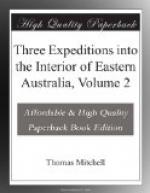These rocks present little or no appearance of stratification.
A remarkably projecting ridge on the banks of Peel’s river contained limestone of so peculiar an aspect as to resemble porphyry, and it was associated with a rock having a base of chocolate-coloured granular felspar. (See Volume 1.)
A yellow highly calcareous sandstone, apparently stratified, occurs near the banks of the Gwydir. Large rounded boulders of argillaceous limestone have been denuded in the bed of Glendon brook; and an impure limestone is found in the neighbourhood of William’s river, both belonging to the basin of the Hunter and not much elevated above the sea. Calcareous tuff or grit may be observed in various localities, and calcareous concretions abound in the blue clay of almost all the extensive plains on both sides of the mountains.
A soft shelly limestone, most probably of recent origin though slightly resembling some of the oolites of England, occurs extensively on the southern coast between Cape Northumberland and Portland bay where it forms the only rock with the exception of amygdaloidal trap.
GRANITE.
Granite or granitic compounds are more or less apparent at or near the sources of the principal rivers; but with the exception of the Southern Alps and some patches in the counties of Bathurst and Murray this fundamental rock is visible in Australia only where it appears to have cracked a thick overlying stratum of ferruginous sandstone. Thus near the head of the river Cox where the latter attains its greatest elevation, and from the character of the valley has evidently been violently disturbed, we find granite in the valley near the bed of the stream.
Observation 1. Such is the character of the country where the waters separate, or in the line of greatest elevation which we are accustomed to term the Coast Range. The general direction of this range is north-north-east and accords perfectly with the hypothesis of Dr. Fitton, founded on the general parallelism observed in the range of the strata, even on the north-western coast, as noticed in his interesting little volume, the first ever devoted to Australian Geology.* The parallelism so remarkable in the range of strata in that portion, the general tendency of the coastlines to a course from the west of south to the east of north on the mainland, and even in the islands west of the Gulf of Carpentaria, and a general elevation of the strata towards the south-east, as deduced from Flinders’ remarks, are all facts which should be studied in connection with the direction of the granite along this part of the eastern coast.
(Footnote. An account of some Geological specimens from the coasts of Australia by William Henry Fitton, M.D., F.R.S., V.P.G.S., etc. 1826.)
Observation 2. It may be also observed that the sandstone reposing on the rock eastward of this division or watershed is slightly inclined towards the sea, whereas all the sandstone on the interior side, or westward of it, dips to the north-west.




